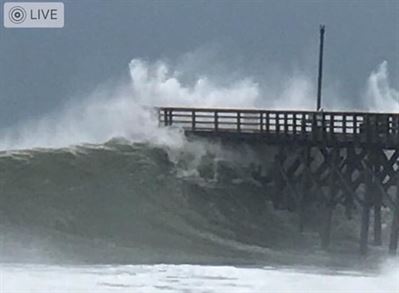Hurricane Florence ripped down the southern East Coast of the United States this past week. Despite its southern track, the storm affected some students at Montclair State University.
“I am terrified for my grandfather and uncle who live right on the ocean [in North Carolina],” said junior family sciences and human development major Emma Black. “I’m not even sure if they will have a home when they get back.”
Black lives in both North Carolina and in New Jersey. News of the hurricane’s track was both shocking and frightening to her.
North Carolina issued both mandatory and voluntary evacuations on Sept. 11 for different areas expected to be hit hard by this storm. By Sept. 14, Hurricane Florence made landfall, which cut power to more than 500,000 customers in both North and South Carolina. By the 16th, Florence had brought more rain to Wilmington, North Carolina than any other weather event recorded in the city’s history.

Emma Black, a Montclair State student with family in North Carolina near Hurricane Florence’s path, poses for a photo.
Mackenzie Robertson | The Montclarion
“I have had contact with [my family] constantly,” Black said. “My family has been blessed so far with being able to have power.”
Other students like Black experienced feelings of worry regarding the effects the storm may have on the southern states. James McChesney, a senior justice studies major, expressed his nerves for his family and friends that live along the coasts of Virginia, North Carolina and South Carolina.
“Luckily everyone we know are doing just fine,” McChesney said. “Everyone I know made it out of the storm with their lives and the extent of their damage was exterior damage to their home.”
McChesney and his family had just returned from a trip to Holden Beach in North Carolina. Originally, the track of the hurricane had the eye heading right over the Holden Beach area.
The storm left many families with only the option of boarding up their homes and leaving north, south or further inland. McChesney said that his family stocked their cars with nonperishable food and water along with their most personal items.
The storm’s violent winds have started to calm and many citizens believe that the worst of Florence is over. However, the flooding water still continues to rise. There have been 31 reported deaths so far, 24 of which include North Carolina citizens.
“It seemed to be a strong storm,” McChesney said. “It was similar to [Hurricane] Irma or [Hurricane] Sandy, and the flooding started quickly.”
A former Montclair State student Leah Bancheri transferred to the College of Charleston in Charleston, South Carolina after attending Montclair State for a year. Bancheri stated that Charleston has a long history of hurricanes and the community is very strong.
“I don’t think anyone really knew where Florence was heading,” Bancheri said in a written statement. “There is no way to really describe how last week felt, and everyone was walking around campus with a phone to their ear trying to find a place to evacuate to.”
Charleston was not affected by the hurricane. However, if it had moved slightly south, the city would have been tremendously damaged with families seeking refuge.
“No one knew what track Florence was going to take until a few days before,” Bancheri said. “My heart goes out to those in North Carolina.”



